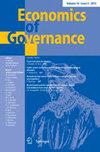Selection rates and bureaucratic performance
IF 0.8
4区 经济学
Q3 ECONOMICS
引用次数: 0
Abstract
Bureaucratic personnel policy influences agency performance by affecting both the types of bureaucrats who are selected for employment and the actions that bureaucrats take. An effective policy selects intrinsically motivated bureaucrats for promotion or retention and provides incentives for bureaucrats to exert a high level of effort. I investigate a retention and promotion policy used in a number of U.S. government agencies in which only a previously specified percentage of bureaucrats in a cohort are retained after one period. The proportion of bureaucrats retained after a review is referred to as a “selection rate”. Using a formal model, I show that the adoption of a selection rate facilitates the separation of intrinsically motivated and unmotivated bureaucrats where they would otherwise pool, allowing bureaucratic personnel managers to screen out unmotivated bureaucrats. Effective screening by itself, however, is not welfare-enhancing because screening removes unmotivated bureaucrats’ incentives to exert effort. Compared to alternative welfare-reducing screening mechanisms which bring about screening through monitoring or wage policy, selection rates facilitate welfare-enhancing screening by inducing motivated types to exert additional effort in order to distinguish themselves from unmotivated bureaucrats. I find that selection rates are most effective where material or ego rents from government employment are high and where the policy rewards that motivated bureaucrats realize are low. These properties of selection rates explain their adoption in several U.S. government agencies’ personnel systems, most notably the military officer corps.遴选率和官僚绩效
官僚人事政策通过影响被选拔聘用的官僚类型和官僚采取的行动来影响机构绩效。有效的政策会选择具有内在动机的官员进行晋升或留任,并激励官员付出高水平的努力。我对美国一些政府机构采用的留任和晋升政策进行了调查,在该政策中,只有事先规定比例的官僚才能在一个时期后留任。审查后留任的官员比例被称为 "遴选率"。通过一个正式的模型,我证明了遴选率的采用有利于将有内在动机和无内在动机的官僚分离开来,使官僚机构的人事管理者能够筛选出无内在动机的官僚。然而,有效的筛选本身并不能提高福利,因为筛选消除了不思进取的官僚努力工作的动力。与通过监督或工资政策实现筛选的其他降低福利的筛选机制相比,遴选率通过诱导有积极性的类型付出额外努力,以将自己与无积极性的官僚区分开来,从而促进了提高福利的筛选。我发现,在政府雇佣的物质或自我租金较高,而有积极性的官僚实现的政策回报较低的情况下,选择率最为有效。遴选率的这些特性解释了为什么美国一些政府机构的人事制度会采用遴选率,尤其是军官制度。
本文章由计算机程序翻译,如有差异,请以英文原文为准。
求助全文
约1分钟内获得全文
求助全文
来源期刊

Economics of Governance
ECONOMICS-
CiteScore
1.50
自引率
0.00%
发文量
22
期刊介绍:
Economics of Governance aims to foster research on governance at many levels: corporations, non-profit organizations, local and federal governments, and international organizations. Applications include the internal organization of firms, corporate governance, the private provision of public goods, local public policies, relations across levels of government, public expenditure and regulation, and problems of credibility and enforcement of international agreements. Though the journal aims to contribute to general economic knowledge, it is also interested in applying theoretical and empirical insights to important current topics. The journal is open to many approaches, including formal theoretical analysis, systematic observation, simulation, and empirical studies. Interdisciplinary contributions by economists, organizational scholars, and political scientists are encouraged.
Officially cited as: Econ Gov
 求助内容:
求助内容: 应助结果提醒方式:
应助结果提醒方式:


